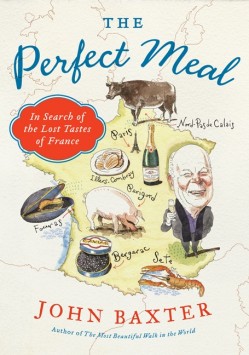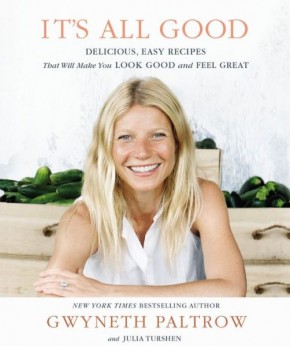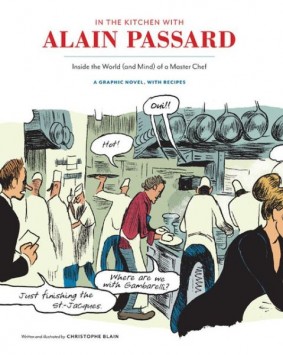Meet Paris OysterA Love Affair with the Perfect Food
From the #1 New York Times bestselling author of French Women Don’t Get Fat comes a memorable look at the French appetite for oysters, the characters who harvest and serve them, and the compelling reasons why we should all enjoy them.
MEET PARIS OYSTER is an engaging exploration of the Parisian love affair with the world’s most sensuous shellfish. It centers on Huîtrerie Régis, a tightly packed oyster bar in the heart of the City of Light, with an opinionated owner and a colorful cast of regulars. Part cultural journey, part cookbook, and part slice-of-life play, this book introduces readers to the appetites (gastronomic and otherwise) of Paris and its people. Beyond Huîtrerie Régis, the French oystermen, and the other characters in pursuit of the oyster, Mireille Guiliano shares information on the best oysters around the world, their nutritional value, the best wine pairings with them, and a dozen mouthwatering recipes that will have readers craving, buying, and preparing oysters with confidence. So take a virtual trip to Paris — indulge and enjoy!
 Mireille Guiliano, a former chief executive at LVMH (Veuve Clicquot), is “the high priestess of French lady wisdom” (USA Today) and “ambassador of France and its art of living” (Le Figaro). She is the author of French Women Don’t Get Fat: The Secret of Eating for Pleasure, the number 1 The New York Times Bestseller in the US. It has been translated into 37 languages. Mireille has appeared on The Today Show, CBS’ The Early Show, NBC’s Dateline, Oprah, CNN, among many national broadcasts, and has been profiled in The New York Times, USA Today, Time, Newsweek, People, Business Week, More, Travel & Leisure, Food & Wine and dozens of other publications, and she is the author of French Women for All Seasons, Women, Work & The Art of Savoir Faire, and The French Women Don’t Get Fat Cookbook.
Mireille Guiliano, a former chief executive at LVMH (Veuve Clicquot), is “the high priestess of French lady wisdom” (USA Today) and “ambassador of France and its art of living” (Le Figaro). She is the author of French Women Don’t Get Fat: The Secret of Eating for Pleasure, the number 1 The New York Times Bestseller in the US. It has been translated into 37 languages. Mireille has appeared on The Today Show, CBS’ The Early Show, NBC’s Dateline, Oprah, CNN, among many national broadcasts, and has been profiled in The New York Times, USA Today, Time, Newsweek, People, Business Week, More, Travel & Leisure, Food & Wine and dozens of other publications, and she is the author of French Women for All Seasons, Women, Work & The Art of Savoir Faire, and The French Women Don’t Get Fat Cookbook.
Oysters and Paris seem to be a perfect combination. Mireille Guiliano documents this classic paring in her new book Meet Paris Oyster; A Love Affair with the Perfect Food. Mireille Guiliano recently took some time to answer a few of our questions.
Booksaboutfood.com(BAF): The research for this book must have been very enjoyable.
Mireille Guiliano: Yes, indeed. I made so many new friends and encountered so much passion from all the oyster and wine people. A treat.
BAF: During the course of researching and writing this book did you uncover anything that surprised you?
Mireille Guiliano: Well, eating the rare pousse en clair from the Marennes opened by M. Papin himself was the best surprise. I only wish I had brought a magnum of champagne but eh nothing /nobody is perfect.
BAF: What is it about oysters that make them so popular?
Mireille Guiliano: Tasting the sea and transporting us somewhere where we can dream. And that they are so good for us.
BAF: What is the best way to convince a non-oyster eater to try one?
Mireille Guiliano: Eating them cooked or fried in my experience.
BAF: Why does Paris have this unique connection with the Oyster?
Mireille Guiliano: Because of the history and the great brasseries serving the seafood platters although today people look for the small oyster bars.
BAF: What’s next for you?
Mireille Guiliano: So many projects but first continuing the mentoring of young women as it seems to be valuable as well as visiting more countries where I am invited to speak. I keep writing although I am not sure I’ll ever publish what’s next…more in the short stories style. I’m also working on a fun project for French Women Don’t Get Fat, and I’ll probably be joining a couple of boards I’ve been invited to chair as they are about helping promote women, and I feel we have been regressing lately.
Huîtrerie Régis, Paris
The initial tip came nearly a decade ago from my Parisian friend Mélanie, who loves oysters almost as much as I do. “Huitrerie Regis has just opened in your neighborhood,” she e‑mailed. “You must go; it’s on the short street between the March. Saint-Germain and the Boulevard Saint-Germain and like no other place in the world . . . Sorry, but they don’t take reservations.” She knew I would love it.
So I went. And went. Between October and May, whenever I am in Paris, it is my cantine, though it is hard to call one of the tiniest restaurants possible a cafeteria. The oyster has a lot to do with why I go to this seemingly one-dish restaurant, but really it is much more than that: a huîtrerie is basically an oyster bar, and there are plenty in town, but this is one of a kind. For one thing, as a regular pointed out to me early on and only semi-jokingly: “Régis picks his customers. And the customer is not zee king here, Régis is.” It is a restaurant with personality and attitude and the highest quality.
I almost blew it with Régis on my first visit. When on a lovely fall day my early-morning plane arrival from New York became a late-morning arrival, I was starving and a bit frustrated, so I thought a few oysters would reconcile me with the world. Plus, I was eager to test this new place. I arrived at almost 2 p.m., but I wasn’t sure they’d serve me as the place was pretty packed (it doesn’t take much for it to be filled), with only one gentleman seemingly ready to leave. A minute later, I had a table. I felt lucky. A great little table pour moi.
The menu arrived immediately, and a fetchingly pert young waitress took my order two minutes later. And then I waited, and waited, and waited. In a one-dish restaurant there is no amuse or appetizers or even a bread basket before the food, and the key in my head had still not switched from New York to Paris art de vivre. My stomach was growling, and I was wondering why it was taking so long to shuck a dozen oysters. Meanwhile, most customers were almost done or chatting over their espresso. I sat, feeling hungrier and hungrier. Edward, my husband of many decades, knows well that I can get grumpy fast when I’m very hungry. I was almost ready to ask if they had forgotten me. Plus, I had been in such a rush to get to the restaurant while it was still serving (2 p.m. is a common cutoff time) that I came without my smart phone or anything to read. So I just sat there, and my expression surely turned into a glare. Régis no doubt read my face and did whatever it took to “lengthen the pleasure,” or test me, as I later learned. He simply ignored me.
Fortunately for me, I overheard a regular next to me mentioning how Régis was in a bad mood today after a morning telephone argument with the credit card machine sales rep, and so patience was required (or was the man observing the show and trying to give me a heads‑up?). That was definitely a hint I took as a favor and kept quiet . . . and waited, and waited, and contemplated the restaurant. Apparently, as I learned after a few visits and conversations with regulars, for someone like Régis, who gets up very early six days a week, rushing is not in order, and those who are in a hurry better go elsewhere. Wow, how is that for customer service? That’s how I learned his number one rule: “Nobody gives me pressure.” A few months later, a single man at the table next to me described what Régis calls difficult customers, or in his lexicon bêtes noires, and his way of turning them down: Let them wait . . . and wait. It’s his definition of the ultimate luxury in business! Customers should be willing to wait.
And so, my platter of oysters was delivered twenty-eight minutes after the order was taken. I was hot inside but tried to be zen or at least look zen. But then it seems that the love affair had started. Without my being aware of it, he discreetly looked at how I approached the bivalves: how I smelled them, tasted them (I had a hard time not devouring them, but then one does not do this with oysters), and followed with a piece of bread with a thick layer of salted butter. I felt right in some sort of gastronomic heaven, and it surely did wonders for the look on my face. Et voilà. Now I somehow had gained approved blessing, though nothing is ever acquired quickly in the world of Régis. And I certainly was not yet a member of the club.
The “short street” is rue Montfaucon in the sixth arrondissement. Huitrerie Régis is at number 3. Now imagine a storefront space that’s about 18 feet wide and 15 feet deep. That’s it, the entire restaurant. Enter the windowed exterior and off to the right, say about six inches, is a small stand‑up bar, more of a serving counter, behind which stands the shucker, the waitress, often Régis, the oysters, the wine, the coffee machine, the sink the size of a pasta pot, the silverware, the glassware, everything. The back wall is the “wine cellar.” A little room is squared off in the opposite back corner, the smallest toilette/WC possible. On one side a table and chairs abut the closet.
In the “dining room,” there are seven small tables accommodating fourteen people. Snug is the operative word. The majority of the tables have inches at most of separation between them. But it works, partly because the French have a way of isolating, encircling themselves in privacy in public. The way Americans are well known for talking to strangers right and left in restaurants, the French are not. The raised platters of oysters also help as territorial delineators. Outside are a couple of sidewalk tables for “smokers” or for those waiting for a table inside or a take-out order of shucked oysters.
Yet this is a spotless, soulful gem of a fancy oyster shack in white and blue, some gold feathers hanging from the ceiling (a holiday fixture), and an interesting large paintingesque work of art on the back wall. Some of us, in a mode of seaside/cityscape fantasy, have decided that when we sit against the back wall facing the outside, we have a seat with a vue sur la mer (sea view). When is a street vista not a sea? You may think the attractive decor is the work of a woman, but it’s all Régis and his sensibilities and sense of aesthetics. What makes the place a tad fancy and indicates that the owner takes the oysters seriously are the white tablecloths with real napkins, real silverware, and beautiful simple plates in white-and-blue porcelain (designed by a Brazilian female artist friend of Régis), and real service (a trio—where the man who shucks is part of the action, the young waitress is superattentive to your needs, and then there is Régis, un personnage attachant, a combination of charm, humor, and the ability to engage that Frenchwomen love. And he is . . . and complicated and comical and demanding and moody). And then there are the oysters . . . zee best. So, it works. It all works.
Consider the menu: it’s simple. On one sheet there are three tasting formulas: (1) twelve oysters fines de claires, a glass of muscadet, and coffee; (2) two types of oysters, six of each with a glass of Sancerre and coffee; and (3) two types of oysters, six of each and six large shrimp. Then there is the second sheet, with Marennes oysters, all by the dozen, going from fines de claires to spéciales de claires and the rare and most expensive pousses en claires; the Belons (second most expensive and not often available); the praires (clams); and when available and up to Régis’s standard, oursins (sea urchins). Again, the quality of the oysters and beyond is very high here, with the least expensive formula costing 25 euros. Not cheap. And at the bottom of that page are some items for non– oyster lovers perhaps dragged here by oyster lovers: terrine of scallops; huge Madagascar shrimp by the dozen; assiette de saucisson (a plate of perhaps a dozen slices of dry sausage); the cheese of the day; and the one and only dessert, tarte aux pommes, made by the master himself every morning.
The wine list is one page, too: a Roederer Champagne (noblesse oblige); one muscadet; two Pouilly-Fum; seven Sancerre white and seven red; a few Burgundies and Bordeaux, some Charentes wines; and a list of digestifs, particularly Armagnac. The coffee is Lavazza. C’est tout. That’s all.
From the book MEET PARIS OYSTER: A Love Affair with the Perfect Food by Mireille Guiliano. Copyright © 2014 by Mireille Guiliano. Reprinted by permission of Grand Central Publishing, New York, NY. All rights reserved.











Leave a Reply